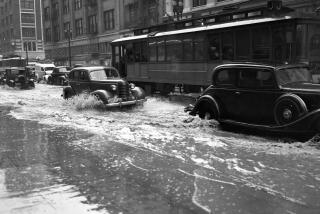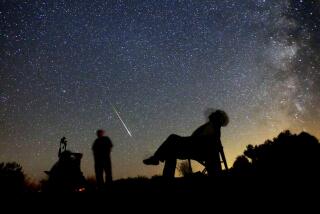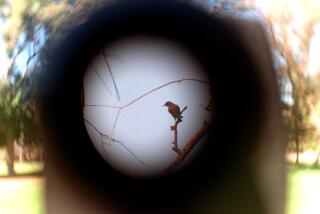BOOK REVIEW : âRaining Fishâ and Other Freaks of Nature : ITâS RAINING FROGS AND FISHES: Four Seasons of Natural Phenomena and Oddities of the Sky, <i> by Jerry Dennis</i> HarperCollins; $19, 323 pages
People who live where bad weather is rare may find it hard to imagine cold so intense that it shatters oneâs teeth, or heat of 130 degrees in the shade for weeks on end. They may find it even harder to imagine rainstorms that leave city streets littered with largemouth bass.
But one can experience these and many other climatic extremes and puzzling phenomena of nature in Jerry Dennisâ amusing and illuminating natural history almanac, âItâs Raining Frogs and Fishes.â
Dennisâs lavishly illustrated treatise is a book-length answer to such kidâs questions as, âWhat makes the sky blue? Where does the wind come from? Why do some clouds rain and others not? Why do some birds fly South in the winter and others stay behind? Why does the moon look different on different nights? Whatâs a tornado?â
Dennis concedes that his own kidsâ innocent questions about nature stumped him at first. Though he and illustrator Glenn Wolff are avid outdoorsmen (they live near each other in Michigan), their kids forced them to realize that they knew woefully little about the natural world.
Dennis says: âSuddenly, simple wonder and curiosity in the face of natural phenomena were no longer adequate. We needed answers.â
Finding answers to their kidsâ questions took Dennis, a veteran magazine writer, and illustrator Wolff, a former staff artist for the New York Times, to the library to study natural historians from classical times to the present day.
The bookâs title chapter, for example, stems from an obscure 1921 scientific paper that described 44 well-documented historical accounts of fish, frogs and other aquatic animals raining down on cities, towns and farms that lay far from any body of water. The paperâs author hypothesized that the creatures were picked up, carried for miles, then deposited by waterspouts.
Despite his reverence for science, though, Dennis does not murder nature in order to dissect it. He is mindful of poet John Keatsâ complaint that scientists would âunweave the rainbowâ if allowed to, so he typically begins his explorations close to the ordinary readerâs home and hearth. For instance, before describing how a tornado works, he recalls a story his policeman father told him.
âMy father heard what sounded like a freight train bearing down on him and before he could run inside, houses two or three doors away exploded, and he was suddenly lifted and pinned against the wall of his house, as if he were being held off his feet by a bully. . . . He watched a tree in his yard bend and twist so violently that the individual fibers in the wood separated the way the strands in a rope separate when you twist it.â
The tree resumed its natural shape as if nothing had happened, Dennis writes, but it had trapped some windblown weeds, which were left protruding from its bark like arrows, as if they had been driven into place by the wind.
After unweaving the mystery of how tornadoes can seem to shoot weeds into trees, Dennis characteristically goes on to discuss more abstract aspects of tornadoes, such as what conditions spawn them, how the storms build and what immense forces they generate, spicing his text with anecdotes worthy of Ripleyâs âBelieve It or Not.â
In this folksy yet sophisticated way, the author explains legions of curious natural phenomena, from the reason kangaroo rats donât drink water to the cause of the moonâs phases.
Dennis even tosses in occasional simple âtry this at homeâ projects. For instance, a handy way to look at the unique structures of snowflakes--known to reach 15 inches in diameter, the author notes--is to cover a square of cardboard with a black cloth. After the cardboard cools to the temperature of the outside air, snowflakes that land on the cloth will last long enough for a good look.
Now and again his enthusiasm seems a bit forced, such as when he dutifully recites what the ancients supposedly believed regarding natural phenomena. Nevertheless, Dennis is generally a masterful storyteller and teacher. And his prose is enhanced in no small way by the 76 edifying and delightful pen-and-ink drawings contributed by illustrator Wolff.
This writer-artist team shines a bright and lovely light on nature.
More to Read
Sign up for our Book Club newsletter
Get the latest news, events and more from the Los Angeles Times Book Club, and help us get L.A. reading and talking.
You may occasionally receive promotional content from the Los Angeles Times.






